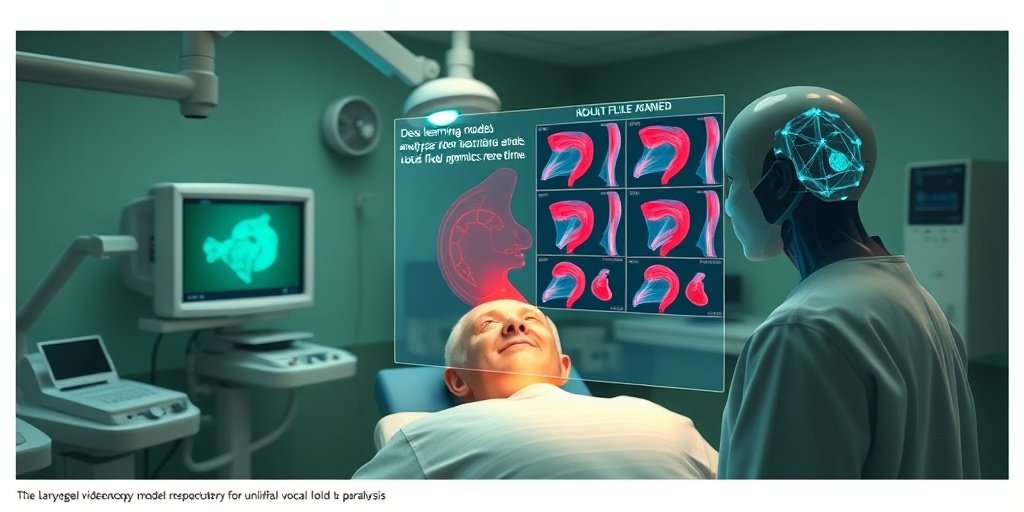⚡ Quick Summary
A recent study developed an auto-diagnostic deep learning model for diagnosing unilateral vocal fold paralysis (UVFP), achieving over 99% accuracy in detecting the condition using video-based analysis. This innovative approach enhances diagnostic capabilities by incorporating temporal motion cues from laryngeal videoendoscopic data.
🔍 Key Details
- 📊 Dataset: 500 participants, 2639 video clips
- 🧩 Features used: Laryngeal videoendoscopic data
- ⚙️ Technology: Deep learning models (image-based and video-based)
- 🏆 Performance: Video-based model: ~99% accuracy in UVFP detection
🔑 Key Takeaways
- 📊 Unilateral vocal fold paralysis (UVFP) is a condition that affects vocal fold mobility.
- 💡 Deep learning models can significantly improve the diagnostic process for UVFP.
- 👩🔬 Video-based analysis outperformed image-based models in predicting laterality and paralysis type.
- 🏆 The video-based model achieved an accuracy of about 99% for UVFP detection.
- 🤖 Incorporating temporal motion cues enhances the diagnostic utility of the model.
- 🏥 This automated approach may assist clinicians in improving workflow efficiency.
- 🌍 Study conducted by a team of researchers published in Sci Rep.
- 🆔 PMID: 40730807

📚 Background
Unilateral vocal fold paralysis (UVFP) is a condition that can lead to significant voice and swallowing difficulties. Traditionally, diagnosis has relied on laryngeal videoendoscopy, which, while effective, can be time-consuming and subjective. The integration of deep learning technologies into this diagnostic process holds promise for enhancing accuracy and efficiency.
🗒️ Study
The study aimed to develop an auto-diagnostic deep learning system for UVFP by utilizing both image-based and video-based models. Researchers trained and validated their models using a comprehensive dataset of laryngeal videoendoscopic data from 500 participants, comprising a total of 2639 video clips.
📈 Results
The image-based deep learning model achieved an impressive accuracy of over 98% for detecting UVFP. However, it struggled with predicting the laterality and type of paralysis. In contrast, the video-based model not only matched this accuracy but also excelled in predicting these additional parameters, demonstrating the importance of analyzing temporal motion cues in video data.
🌍 Impact and Implications
The findings from this study could significantly impact the field of otolaryngology by providing a reliable, automated tool for diagnosing UVFP. By enhancing diagnostic performance and workflow efficiency, this deep learning model may serve as a valuable complement to traditional assessment methods, ultimately improving patient care and outcomes.
🔮 Conclusion
This study highlights the transformative potential of deep learning technologies in the diagnosis of unilateral vocal fold paralysis. By leveraging video-based analysis, healthcare professionals can achieve higher accuracy and efficiency in their assessments. The future of AI in clinical diagnostics looks promising, and further research in this area is encouraged to explore its full potential.
💬 Your comments
What are your thoughts on the use of deep learning for diagnosing vocal fold paralysis? We would love to hear your insights! 💬 Leave your comments below or connect with us on social media:
Diagnosis of unilateral vocal fold paralysis using auto-diagnostic deep learning model.
Abstract
Unilateral vocal fold paralysis (UVFP) is a condition characterized by impaired vocal fold mobility, typically diagnosed using laryngeal videoendoscopy. While deep learning (DL) models using static images have been explored for UVFP detection, they often lack the ability to assess vocal fold dynamics. We developed an auto-diagnostic DL system for UVFP using both image-based and video-based models. Using laryngeal videoendoscopic data from 500 participants, the model was trained and validated on 2639 video clips. The image-based DL model achieved over 98% accuracy for UVFP detection, but demonstrated limited performance in predicting laterality and paralysis type. In contrast, the video-based model achieved comparable accuracy (about 99%) in detecting UVFP, and substantially higher accuracy in predicting laterality and paralysis type, outperforming the image-based model in overall diagnostic utility. These results demonstrate the advantages of incorporating temporal motion cues in video-based analysis and support the use of DL for comprehensive, multi-task assessment of UVFP. This automated approach demonstrates high diagnostic performance and may serve as a complementary tool to assist clinicians in the assessment of UVFP, particularly in enhancing workflow efficiency and supporting multi-dimensional interpretation of laryngeal motion.
Author: [‘Yang KO’, ‘Kim SY’, ‘Kang CW’, ‘Choi JS’, ‘Ji YB’, ‘Tae K’, ‘Choi JW’, ‘Song CM’]
Journal: Sci Rep
Citation: Yang KO, et al. Diagnosis of unilateral vocal fold paralysis using auto-diagnostic deep learning model. Diagnosis of unilateral vocal fold paralysis using auto-diagnostic deep learning model. 2025; 15:27635. doi: 10.1038/s41598-025-09797-z